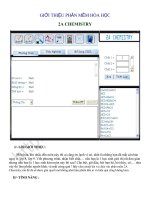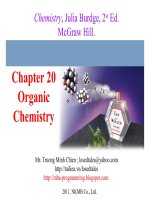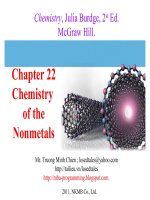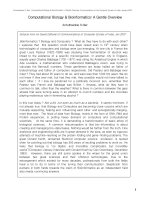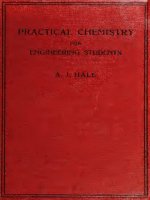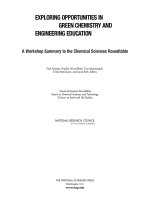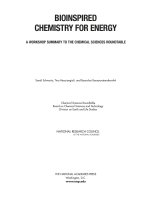Computational organometallic chemistry
Bạn đang xem bản rút gọn của tài liệu. Xem và tải ngay bản đầy đủ của tài liệu tại đây (4.64 MB, 441 trang )
ISBN: 0-8247-0478-9
This book is printed on acid-free paper.
Headquarters
Marcel Dekker, Inc.
270 Madison Avenue, New York, NY 10016
tel: 212-696-9000; fax: 212-685-4540
Eastern Hemisphere Distribution
Marcel Dekker AG
Hutgasse 4, Postfach 812, CH-4001 Basel, Switzerland
tel: 41-61-261-8482; fax: 41-61-261-8896
World Wide Web
http:/ /www.dekker.com
The publisher offers discounts on this book when ordered in bulk quantities. For more
information, write to Special Sales/Professional Marketing at the headquarters address
above.
Copyright 2001 by Marcel Dekker, Inc. All Rights Reserved.
Neither this book nor any part may be reproduced or transmitted in any form or by any
means, electronic or mechanical, including photocopying, microfilming, and recording,
or by any information storage and retrieval system, without permission in writing from
the publisher.
Current printing (last digit):
10 9 8 7 6 5 4 3 2 1
PRINTED IN THE UNITED STATES OF AMERICA
Preface
This book is intended to fill a gap in the literature by covering a broad range
of topics in computational organometallic chemistry. Two objectives were foremost in putting together this volume. First, pedagogical aspects are emphasized
throughout. The particular challenges inherent in reliable modeling (quantum or
classical) in organometallic chemistry are discussed, and strategies for addressing
these challenges are offered. Second, ‘‘how-to’’ aspects are complemented with
applications-oriented material covering a wide spectrum of research areas, including catalysis, medicine, organic synthesis, actinide chemistry, and so forth. The
first goal will assist those who may have limited experience in computational
organometallic chemistry research upon entering this exciting and dynamic field.
The second objective will provide motivation for undertaking such an intellectual
journey.
Computational Organometallic Chemistry has been written to be accessible
to a general scientific audience. These pages will provide upper-division undergraduate students and graduate students with useful lessons that can be employed
in their future scientific endeavors, while the applications chapters will spark
future research contributions. Similarly, senior researchers, academic and industrial, who may wish to bring their energies to bear on this field will find both
iii
iv
Preface
motivation and suitable background to do so. To accomplish these ambitious
goals, an internationally recognized group of experts has been assembled, each
focusing on his or her particular area of expertise within this growing field of
science.
Thomas R. Cundari
Contents
Preface
Contributors
iii
ix
1. Introduction
Thomas R. Cundari
1
2. Recipe for an Organometallic Force Field
Per-Ola Norrby
7
3. Computational Approaches to the Quantification of Steric
Effects
David P. White
39
4. The Accuracy of Quantum Chemical Methods for the
Calculation of Transition Metal Compounds
Michael Diedenhofen, Thomas Wagener, and Gernot Frenking
69
v
vi
Contents
5. Nondynamic Correlation Effects in Transition Metal
Coordination Compounds
Kristine Pierloot
123
6. Quantitative Consideration of Steric Effects Through Hybrid
Quantum Mechanics/Molecular Mechanics Methods
Feliu Maseras
159
7. HIV Integrase Inhibitor Interactions with Active-Site Metal
Ions: Fact or Fiction?
Abby L. Parrill, Gigi B. Ray, Mohsen Abu-Khudeir, Amy Hirsh
and Angela Jolly
8. Cyclometallation of a Computationally Designed Diene:
Synthesis of (Ϫ)-Androst-4-ene-3,16-dione
Douglass F. Taber, James P. Louey, Yanong Wang, and
Wei Zhang
9. Rhodium-Mediated Intramolecular C–H Insertion: Probing the
Geometry of the Transition State
Douglass F. Taber, Pascual Lahuerta, James P. Louey, Scott
C. Malcolm, Robert P. Meagley, Salah-eddine Stiriba, and
Kimberly K. You
185
205
217
10. Molecular Mechanics Modeling of Organometallic Catalysts
David P. White and Warthen Douglass
237
11. Titanium Chemistry
Mark S. Gordon, Simon P. Webb, Takako Kudo, Brett M. Bode,
Jerzy Moc, Dmitri G. Fedorov, and Gyusung Chung
275
12. Spin-Forbidden Reactions in Transition Metal Chemistry
Jeremy Noel Harvey
291
13. Oxidative Addition of Dihydrogen to M(PH3)2Cl, M ϭ Rh
and Ir: A Computational Study Using DFT and MO Methods
Margaret Czerw, Takeyce K. Whittingham, and Karsten
Krogh-Jespersen
14. The Electronic Structure of Organoactinide Complexes via
Relativistic Density Functional Theory: Applications to the
323
Contents
Actinocene Complexes An(η8-C8H8)2 (An ϭ Th–Am)
Jun Li and Bruce E. Bursten
vii
345
15. Pi Bonding in Group 13–Group 15 Analogs of Ethene
Ashalla McGee, Freida S. Dale, Soon S. Yoon, and Tracy P.
Hamilton
381
16. Main Group Half-Sandwich and Full-Sandwich Metallocenes
Ohyun Kwon and Michael L. McKee
397
Index
425
Contributors
Mohsen Abu-Khudeir, B.S. Department of Chemistry, The University of
Memphis, Memphis, Tennessee
Brett M. Bode, Ph.D. Applied Mathematical Sciences, Ames Laboratory, Iowa
State University, Ames, Iowa
Bruce E. Bursten, Ph.D. Department of Chemistry, The Ohio State University,
Columbus, Ohio
Gyusung Chung, Ph.D. Department of Chemistry, Konyang University,
Chungnam, Korea
Thomas R. Cundari, Ph.D. Department of Chemistry, Computational Research on Materials Institute, The University of Memphis, Memphis, Tennessee
Margaret Czerw, B.A. Department of Chemistry, Rutgers, The State University of New Jersey, New Brunswick, New Jersey
ix
x
Contributors
Freida S. Dale, B.S. Department of Chemistry, The University of Alabama at
Birmingham, Birmingham, Alabama
Michael Diedenhofen, Dipl.Chem. Department of Chemistry, Philipps-Universita¨t Marburg, Marburg, Germany
Warthen Douglass, M.S. Department of Chemistry, University of North Carolina at Wilmington, Wilmington, North Carolina
Dmitri G. Fedorov, Ph.D. Department of Applied Chemistry, School of Engineering, University of Tokyo, Tokyo, Japan
Gernot Frenking, Ph.D. Department of Chemistry, Philipps-Universita¨t Marburg, Marburg, Germany
Mark S. Gordon, Ph.D. Department of Chemistry, Iowa State University,
Ames, Iowa
Tracy P. Hamilton, Ph.D. Department of Chemistry, The University of Alabama at Birmingham, Birmingham, Alabama
Jeremy Noel Harvey, D.Sc. School of Chemistry, University of Bristol, Bristol, England
Amy Hirsh, B.S. Department of Chemistry, The University of Memphis, Memphis, Tennessee
Angela Jolly, B.S. Department of Chemistry, The University of Memphis,
Memphis, Tennessee
Karsten Krogh-Jespersen, Ph.D. Department of Chemistry, Rutgers, The
State University of New Jersey, New Brunswick, New Jersey
Takako Kudo, Ph.D. Department of Fundamental Studies, Faculty of Engineering, Gunma University, Kiryu, Japan
Ohyun Kwon, M.S. Department of Chemistry, Auburn University, Auburn,
Alabama
Pascual Lahuerta, Ph.D. Department of Inorganic Chemistry, University of
Valencia, Valencia, Spain
Contributors
xi
Jun Li, Ph.D. Department of Chemistry, The Ohio State University, Columbus,
Ohio
James P. Louey, Ph.D. Department of Chemistry, Sacred Heart University,
Fairfield, Connecticut
Scott C. Malcolm, Ph.D. Department of Chemistry and Chemical Biology,
Harvard University, Cambridge, Massachusetts
Feliu Maseras, Ph.D. Division of Physical Chemistry, Department of Chemistry, Universitat Auto`noma de Barcelona, Barcelona, Catalonia, Spain
Ashalla McGee, B.S. Department of Chemistry, The University of Alabama
at Birmingham, Birmingham, Alabama
Michael L. McKee, Ph.D. Department of Chemistry, Auburn University, Auburn, Alabama
Robert P. Meagley, Ph.D. Fab Materials Operation, Intel Corporation, Hillsboro, Oregon
Jerzy Moc, Ph.D. Faculty of Chemistry, Wroclaw University of Technology,
Wroclaw, Poland
Per-Ola Norrby, Ph.D.* Department of Medicinal Chemistry, Royal Danish
School of Pharmacy, Copenhagen, Denmark
Abby L. Parrill, Ph.D. Department of Chemistry, The University of Memphis,
Memphis, Tennessee
Kristine Pierloot, Ph.D. Department of Chemistry, Catholic University of
Leuven, Leuven, Belgium
Gigi B. Ray, Ph.D. Department of Chemistry, The University of Memphis,
Memphis, Tennessee
Salah-eddine Stiriba, Ph.D. Department of Inorganic Chemistry, University
of Valencia, Valencia, Spain
*Current affiliation: Technical University of Denmark, Lyngby, Denmark.
xii
Contributors
Douglass F. Taber, Ph.D. Department of Chemistry and Biochemistry, University of Delaware, Newark, Delaware
Thomas Wagener, Ph.D. Department of Chemistry, Philipps-Universita¨t Marburg, Marburg, Germany
Yanong Wang, Ph.D. Division of Chemical Sciences, Wyeth-Ayerst Research,
American Home Products, Pearl River, New York
Simon P. Webb, Ph.D. Department of Chemistry, Pennsylvania State University, University Park, Pennsylvania
David P. White, Ph.D. Department of Chemistry, University of North Carolina
at Wilmington, Wilmington, North Carolina
Takeyce K. Whittingham, B.A. Department of Chemistry, Rutgers, The State
University of New Jersey, New Brunswick, New Jersey
Soon S. Yoon, B.S. Department of Chemistry, The University of Alabama at
Birmingham, Birmingham, Alabama
Kimberly K. You, Ph.D. Plastics Application Center, BASF Corporation,
Wyandotte, Michigan
Wei Zhang, M.S. Process Research and Development, Bristol-Myers Squibb
Pharmaceutical Research Institute, New Brunswick, New Jersey
1
Introduction
Thomas R. Cundari
The University of Memphis, Memphis, Tennessee
When I was invited to edit a volume on computational organometallic chemistry
by the good folks at Marcel Dekker, I accepted with enthusiasm. My eagerness
for this project sprang primarily from the fact that this monograph covers two
types of chemistry that are near and dear to my heart—computational and organometallic. Additionally, after canvassing colleagues, experimental and computational, I felt that there would be sufficient interest in this undertaking from the
scientific community. Perhaps most importantly, from these discussions there
emerged a consensus that the time was ripe for just such a project.
The application of modern computational techniques to organometallic
chemistry has truly undergone a renaissance in the past few years, as is more
than evident from the breadth of methods and topics discussed in this book.
Through the hard work and perseverance of numerous research groups around
the globe, many of the challenges involved in modeling these species, particularly
those concerning the reliable and efficient modeling of metallic elements, have
been addressed. The computational chemist now has a much larger (not to mention more effective) arsenal in dealing with organometallic compounds than just
a few short years ago. As is evident from the chapters in Computational Organometallic Chemistry, developments have occurred within the realm of quantum
and classical techniques, as well as hybrid quantum-classical approaches.
1
2
Cundari
Another major motivation for this volume is to organize in a single place
much of the hard-won experience that speaks to the ‘‘how to’’ of computational
organometallic chemistry. This monograph brings together experts in the field
and is designed to combine instructional aspects with cutting-edge applications.
The former are intended to introduce this exciting research field to those, experimentalists and theorists alike, who might wish to try their hand at computational
organometallic chemistry, while the latter should provide motivation for embarking on the journey.
As we start the new millennium, we see that the face of scientific research
has changed dramatically in just the past decade. Two of the most important
trends are the growing importance of computers in all aspects of scientific research and the increasing interdisciplinary nature of the science being undertaken.
These tendencies are well represented in the present volume. Computational
chemistry and organometallic chemistry are, almost by definition, interdisciplinary endeavors. The latter exists at the interface between inorganic and organic
chemistry, providing erstwhile inorganic chemists a chance to try their hand at
making new organometallic compounds by manipulation of the metal and its
environs. Closet organic chemists also play a major role in organometallic chemistry through their attention to the organic functionalities. Computational chemistry has also metamorphosed from its origins as a branch of physical chemistry to
embracing all traditional and nontraditional chemical disciplines. Computational
chemists now routinely tackle problems in organic, inorganic, analytical, materials, and biological chemistry, and the list goes on.
In many respects, progress in computational organometallic chemistry has
traditionally lagged behind other areas, because it combines the inherent challenges of both organic and inorganic modeling. An organometallic compound,
as the name implies, is made up of two chemical regions—a metallic ‘‘core’’
and an organic ‘‘coating’’—if I might be allowed a little poetic license. The
organic coating is often characterized by its large size, large in terms of the number of atoms, orbitals, and/or conformational possibilities. It takes very few tbutyl substituents before a calculation on an organometallic compound becomes
onerous! For the metallic core, i.e., the metal (or metals) and its surrounding inner
coordination sphere, the inherent challenges for the computational organometallic
chemist are different. Metals, particularly those of the d- and f-block, typically
give rise to three main challenges in their chemical modeling: the large number
of orbitals (many of them core), the so-called electron correlation problem (which
is exacerbated by the presence of low-energy excited states), and relativistic effects for the heaviest metals.
Two techniques for dealing with these challenges, effective core potentials
(or pseudopotentials) and density functional theory, have quickly transformed
themselves from marginal techniques, once primarily the domain of solid-state
chemists and physicists, to almost de rigueur standards for the computational
Introduction
3
organometallic chemist. This is due in part to computational improvements but
perhaps, more importantly, to the inclusion of these techniques into powerful,
yet user-friendly, computational chemistry packages.
Another trend, and a very welcome one at that, in modern computational
organometallic chemistry is in some respects a return to the roots of computational chemistry. In the Stone Age (at least according to some of the students who
have worked in my research group), hardware and software limitations forced the
utilization of less qualitative methodologies. This is best typified by the unparalleled work of Hoffmann and his colleagues employing extended Hu¨ckel methods.
Much of this work spoke to the ‘‘how’’ and ‘‘why’’ of organometallic chemistry,
with less concern for ‘‘how much.’’ For a while, it seemed that the only trend
in computational organometallic chemistry was to be more quantitative, particularly for nongeometric quantities, such as reaction energies. This increase toward
what some have termed chemical accuracy was certainly needed for the field to
realize its full promise, but in many cases quantitative concerns overshadowed
qualitative insight. Chapter 5, by Pierloot, shows that fundamental chemical insight, and not just accurate energies and bond lengths, can be extracted from
even the most high-level calculations. Likewise, Chapters 3 and 6, by White and
Maseras, respectively, tackle an age-old problem in chemistry, quantification of
steric effects, in the former using molecular mechanics techniques and in the
latter with hybrid quantum mechanics/molecular mechanics approaches.
In putting together this volume, the overriding theme was diversity—diversity of methods, diversity of applications, and diversity of chemistry. The ‘‘something for everyone’’ approach is not only an attempt to attract the largest possible
audience for this book, but is also meant to highlight the amazing breadth and
depth of computational organometallic chemistry. Chapters 2, 3, and 10, respectively by Norrby, White, and White and Douglass, focus primarily on classical
(molecular mechanics) descriptions of chemical bonding. Of course, quantum
mechanical approaches receive attention. Diedenhofen et al. (Chap. 4) and Gordon et al. (Chap. 11) address the accuracy of different quantum chemical techniques.
At one extreme of quantum chemical methodology lie approximate methods. Such techniques (for example, semiempirical quantum mechanics) typically
involve great latitude in the number and type of approximations made to the full
Schro¨dinger treatment. Approximations generally involve either the replacement
of difficult-to-calculate quantities with experimental or theoretical estimates or
the neglect of interactions (typically between electrons) thought to be of less
chemical importance. Hence, the tradeoff for approximate methods is one of computational efficiency versus accuracy. The balance between accuracy and speed
can be quite problematic for semiempirical quantum calculations on organometallic compounds because of the challenges discussed earlier for modeling metal
species. The development or extension of any approximate method (molecular
4
Cundari
mechanics included) has a prerequisite parameterization phase. In this process,
one seeks to determine those parameters that maintain computational efficiency
(not to mention realistic chemistry and physics) while maximizing the descriptive
and predictive power of the model. Ideally, the parameterization process should
take into account the full range of motifs that characterize a chemical family. One
major issue in the parameterization of approximate methods for metal-containing
species is therefore the development of a robust parameterization that can handle
what our group has termed ‘‘chemical diversity.’’ Progress has been made in this
field, not only for the molecular mechanics approaches alluded to earlier (see,
for example, Chapter 2, by Norrby), but also for semiempirical quantum mechanics, as typified by the chapters of Taber (Chaps. 8, 9).
Chemical diversity can be defined as the ability of metals to stabilize distinct bonding environments involving different bond (e.g., dative, single, and
multiple bonds) and ligating-atom (e.g., hard and soft donors) types, spin and
formal oxidation states, coordination numbers, and geometries. Chapter 12, by
Harvey, is an excellent example of the challenges inherent in modeling organometallic species and processes in which ‘‘spin flips’’ occur. As has become apparent, as computational organometallic chemists have explored all regions of the
periodic table, this chemical diversity is also part and parcel of elements other
than those of the transition series. This is plainly evident in the contributions by
Kwon and McKee (Chap. 16) and McGee et al. (Chap. 15) on main group chemistry and by Li and Bursten (Chap. 14) on organoactinides.
It can be argued that the tremendous growth in the popularity of research
into organometallic chemistry, experimental and computational, is due in large
part to their utility in industrial and academic applications. As the field of computational organometallic chemistry has matured it has become evident that it is
the chemical diversity that characterizes these entities that gives rise to many of
the challenges in their reliable and rapid modeling. One need only consider some
of the myriad catalytic transformations involving organometallic species to appreciate the chemical gymnastics that alter oxidation states, coordination numbers, ligand types, etc. Thus, it is this very property of chemical diversity that
makes organometallics so very interesting (and at times quite frustrating) as computational targets.
In putting together this volume, the traditional description of organometallics as entities with a metal–carbon bond has been expanded to include any entities with an organic and metallic functionality, whether they be joined by a direct
metal–carbon bond or not. I have also tried to go beyond applications other than
just those related to industrial catalysis, as admirably demonstrated by Czerw et
al. in Chapter 13. Chapter 7, by Parrill and coworkers, with its biomedical bent,
is a good demonstration of this philosophy, as are Chapters 8 and 9, by Taber
et al., on the computer-aided design of organometallic catalysts for carrying out
useful organic synthetic transformations.
Introduction
5
I would like to conclude this introductory chapter by thanking the chapter
authors, individually and as a group, for their good humor and spirit, particularly
in dealing with the inadequacies of a first-time editor. I would also like to thank
Anita Lekhwani (Acquisitions Editor), Moraima Suarez (Production Editor), and
Jennifer Paizzi (Administrative Assistant) of Marcel Dekker for their encouragement and for answering my numerous questions. Much of the planning for Computational Organometallic Chemistry occurred while I was on a Professional
Development Assignment (PDA), for which opportunity I am grateful to The
University of Memphis College of Arts and Sciences and Chemistry Department.
I’d also like to thank the Chemistry Department at Bristol University (UK), for
providing a relaxing yet stimulating environment during this PDA, and the United
States National Science Foundation Office of International Programs, for their
support of travel between Memphis and Bristol. It would not have possible to
become an ‘‘expert’’ (real or imagined) in computational organometallic chemistry without the hard work and dedication of a fabulous bunch of graduate and
undergraduate research students at The University of Memphis. I thank the various agencies (American Chemical Society—Petroleum Research Foundation,
Los Alamos National Laboratory, National Science Foundation, and U.S. Department of Energy) for their generous support of these students during their careers
at The University of Memphis.
Saving the best for last, I would like to thank my lovely wife, Mary Anderson, for her support, suggestions, and spirited Texan ways. She has done more
than help improve this monograph; she has improved my life in immeasurable
ways. For these reasons, I dedicate this volume to her.
Finally, I take full responsibility for any errors of commission or omission
that may exist in this volume.
2
Recipe for an Organometallic Force Field
Per-Ola Norrby*
Royal Danish School of Pharmacy, Copenhagen, Denmark
1. INTRODUCTION
The molecular mechanics (MM) method is well established in organic chemistry
(1–4). For many types of molecules, reliable structures can be generated quickly
and conformational energies can be calculated with a high degree of accuracy (5).
Combination of force field methods with dynamic or stochastic schemes allows
determination of thermodynamic and solvation properties (1–3). Force fields are
routinely applied to large systems, consisting of several thousand atoms. It is
also possible to perform exhaustive searches for low-energy conformations of
molecules with 10–20 freely rotatable bonds (6). Compared to computational
methods based on quantum mechanical (QM) calculations, force field methods
are limited in scope, since only systems with identical bonding (i.e., conformers
or diastereomers) can be directly compared. However, within this limitation, force
fields are several orders of magnitude faster than any QM method. In addition,
when high-quality parameters are available, the accuracy of force fields is competitive with standard QM methods, such as MP2 and B3LYP, and better than
semiempirical schemes (5).
The situation is different for organometallic complexes. The tools and
methods developed for organic systems are available, but application is hampered
*Current affiliation: Technical University of Denmark, Lyngby, Denmark.
7
8
Norrby
by a lack of parameters. Metal systems are structurally more diverse than organic
compounds (7). As an example, the C–O–C bond angle seldom deviates more
than a few degrees from true tetrahedral, whereas observed P–Pd–P angles vary
over a range of ca. 100° depending on coordination geometry and steric requirements. Thus, parameter transferability between different types of complexes is
limited, and alternative functional forms may be required (vide infra) (8,9). Despite the apparent difficulties, several force fields exist that allow calculations to
be performed for almost any type of complex (10). However, predictivity may
well be low for complexes outside the set used in parameter generation (11).
An alternative approach, which will be pursued here, is to tailor a force
field to one specific type of complex. For organometallic complexes, it is still
possible to use existing parameters for the organic part of the system and to
develop new parameters only for the coordination sphere. Many examples can
be found in the literature (8,9,12), but the need to develop new parameters largely
limits applications to force field experts, as opposed to the organic field, where
practicing chemists can easily model the system with only basic computational
experience. The goal of the current chapter is to simplify the process of producing
a high-quality organometallic force field by providing a workable recipe for the
procedure. Some examples from the literature are included, but the coverage is
by no means complete.
1.1.
Force Fields
A force field is essentially a relationship between the geometry of a molecule
and the force on each atom. The force is a vector quantity, the derivative of the
energy with respect to coordinates. To simplify the expressions, force fields are
generally presented in the form of energy as a function of coordinates. The true
zero of the energy is an unknown, different for each force field and molecule.
Thus, the total energy calculated for any molecule cannot be interpreted in a
physically meaningful way, and no special meaning should be attached to a calculated energy of zero (or a negative energy). However, when two energies are
calculated from exactly the same functions (i.e., when the connectivities of two
structures are identical), the unknown constants be considered identical, and the
energies can be compared directly.*
One of the fundamental postulates of molecular mechanics is that the steric
energy of a molecule can be separated into terms resulting from small, transferable moieties. For all bond lengths and angles, it is assumed that there exists an
unstrained state with a steric energy of zero. All deviations from this ‘‘ideal’’
*Formal heats of formation can be calculated from steric energies by adding geometry-independent
terms for several structural features; see Ref. 4. By this method, structural isomers with different
connectivity can also be compared.
Recipe for an Organometallic Force Field
9
FIGURE 1 A simple force field.
value will give rise to an energy increase.* It is generally impossible for all
interactions to achieve their unstrained state in the same geometry, and thus
the ‘‘ideal values’’ will never be directly observed, but in organic molecules, the
deviations from the unstrained state are usually small. Other contributions to the
total energy of the molecule come from rotations around bonds as well as nonbonded interactions. In order to reproduce strained structures or vibrational data,
it has also been found necessary to employ cross-terms in the force field. An
example is the stretch–bend interaction, which can be described as the change
in a bond angle function when the constituent bonds are distorted. For trigonal
atoms, it is also common to employ a term that differentiates between planar and
pyramidal form (an out-of-plane or inversion term).
The functional form of a simple example force field is shown in Figure 1.
Most current force fields are substantially more complicated, but the additions
take many different forms and will not be covered here. For more detailed accounts, see, for example, Refs. 1 and 4.
The basic unit of a force field is the atom type. In general, there is at least
one atom type for each element, more if several chemical environments are to
be considered. For example, all force fields differentiate between sp2 and sp3
hybridized carbons, assigning a distinct atom type to each. For organometallic
modeling, it is frequently necessary to add new metal atom types to existing force
fields. Even when the metal atom types exist in the force field, there is seldom
any differentiation based on, for example, oxidation state.† Atom types are used
to classify other interactions. Any unique pair of connected atom types identifies
a bond type; an angle type is labeled by a unique set of three connected atoms,
etc. Each unique interaction type needs its own set of parameters. Many atom*The l0 and θ0 parameters are also called reference values. But to avoid confusion with bond and angle
‘‘reference data,’’ the term ideal values will be used for these parameters throughout this chapter.
†One exception is the PCModel program, which allows at least a basic differentiation, see Ref. 10c.
10
Norrby
type combinations will not have existing parameters; in particular the torsions
would require determination of millions of parameters for a complete set.
1.2.
Parameters
A complete force field consists of a functional form, as exemplified in Figure 1,
and a set of parameters. For example, for each type of bond in the example force
field, two parameters are needed: an ideal length l0 (corresponding to the bond
length in a hypothetical unstrained molecule), and a stretching force constant ks.
The latter can be seen as the relative stiffness of the bond, and determines how
much the energy increases upon a certain distortion. Some parameters, such as
the ideal bond length, correspond closely to observables. However, the optimum
set of parameters can rarely be identified by observation.
Take the torsional parameters for the central bond in butane as an example
(Fig. 2). There are several observable energies that are closely related to the νnparameter (Fig. 1), but each is also affected strongly by other parameters. The
rotation barrier might be taken as the amplitude of a threefold cosine function
(when n ϭ 3, ν3 ϭ ∆E‡rot /2 will give an energy difference of ∆E‡rot between the
lowest and highest point on the torsional profile). But in reality part of the barrier
is due to van der Waals (vdW) repulsion, so ν3 should be less than half the
observed barrier. Likewise, the conformational difference between gauche and
anti forms is largely determined by vdW interactions, but the remaining error
might be reproduced using an added ν1 parameter in the force field (the ν3 parameter has no influence on the relative energy of gauche and anti forms, because the
contribution from ν3 cos 3ω must always be equal at 60° and 180°).
From vibrational or microwave spectroscopy it is possible to obtain the
curvature at the bottom of each well. Ignoring mixing with other structural elements, this corresponds to the second derivative of the energy with respect to
the torsional angle, ∂ 2 E/∂ω2. Fitting to this observable may require either sacri-
FIGURE 2
Butane torsional profile.
Recipe for an Organometallic Force Field
11
ficing some accuracy for other data points or adding more torsional terms (i.e.,
n ϭ 1, 2, and 3, Fig. 1). When a substantial amount of data is used, no term in
the final force field corresponds to only one type of observable. Instead, the optimal value for each parameter is that which, together with all other terms in the
force field, gives the best overall fit to all observables. This concept will be defined more rigorously in Section 3.1. However, it should be clear that changing
any parameter might lead to a shift in the optimum value for several others.
Despite what was said in the preceding paragraph, most parameters depend
closely on some specific type of data. Good starting values for further refinement
can therefore be obtained by manual fitting of one parameter at a time to small
subsets of the reference data. The most intuitive example is the ideal bond lengths
and bond angles (l0 and θ0, Fig. 1). Averages of observed values (possibly after
removal of outliers) are good initial estimates for these parameters. Other examples are given in subsequent sections.
1.3. Parameterization
Defining new force fields has long been as much an art as a science. In the
literature, there are two major schools on how to derive force field parameters,
manually (4,13) and automatically (14). The manual method has the advantage
of creating a deep familiarity with the force field and data, but it requires great
expertise. Moreover, when the parameter set grows large, it becomes slow and
tedious to ensure that fitting to new data retains consistency with all previously
optimized sets.
An automated parameterization may be difficult to set up. But when this
has been accomplished, the process is substantially faster than the manual
method, and much larger bodies of data can be fitted simultaneously. The main
drawback of the automated scheme is that errors may remain undetected more
easily than in manual parameterization. Automated parameterization therefore
requires substantial validation to identify outliers in the data set and deficiencies
in the force field. Statistical tools should be used to verify that each parameter
is well defined by the chosen set of reference data, and any ill-fitting data points
can be rationalized on sound physical grounds.
The necessary steps in executing an automated parameterization for an
organometallic complex are outlined in Figure 3 (15). Each step will be detailed
in later sections. Selecting the basic force field is possibly the most critical step.
The functional form of the basic force field must be flexible enough to accommodate the variability in metal complexes (7). In addition, the existing parameters
for organic moieties will usually not be modified and will therefore limit the
accuracy that can be obtained for organic ligands.
The target for an automated parameterization sequence is to enable the
force field to reproduce a set of reference data, such as structures and relative
12
FIGURE 3
Norrby
Parameterization flowchart.
energies. The quality of the reference data will therefore limit the attainable accuracy in the final force field. The accuracy can be improved by using large data
sets, because random errors are expected to cancel to some extent. However, any
systematic errors will be propagated into the final force field. It is also necessary
to weight the reference data points, according to both quality and relevance to
the intended use of the force field.
With the basic ingredients in hand, the next step is to set up a working
force field. It is not necessary at this point to achieve a good fit, but the force
field should allow calculations for all structures needed to reproduce the reference
data set. This involves choosing functional forms for bonds and angles involving
the metal and then guessing reasonable values for all previously undefined parameters. When all of this is accomplished, automatic procedures can vary the param-
